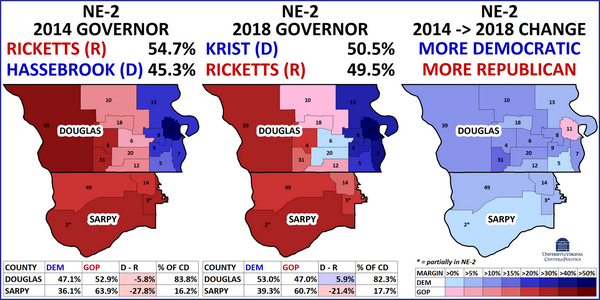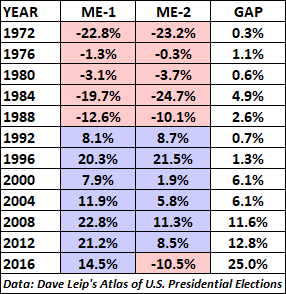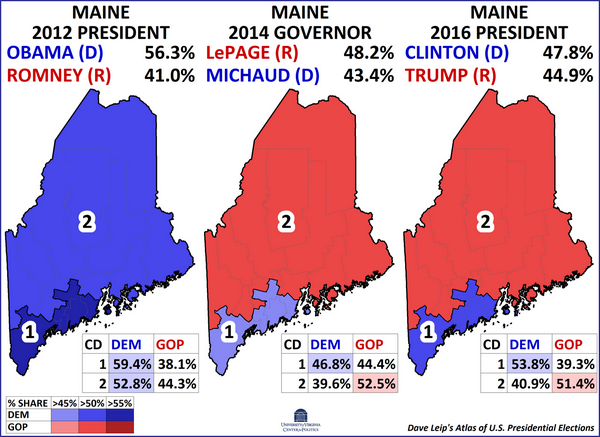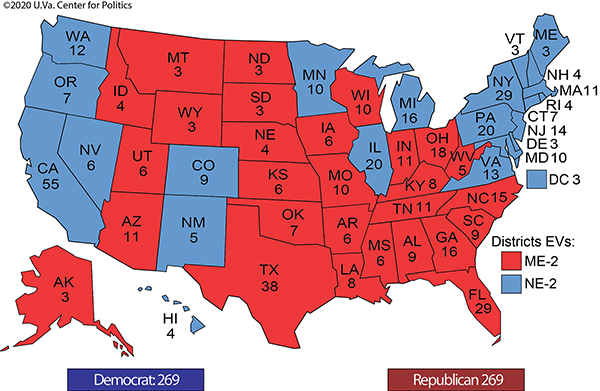KEY POINTS FROM THIS ARTICLE
— Nationalization has pushed urban and rural areas apart; Maine and Nebraska are no exceptions to this trend, and their unique electoral vote allocation systems are highlighting that division.
— The Omaha-based NE-2 supported Republicans in the past two presidential elections, but by decreasing margins, and could feasibly vote blue in 2020.
— Maine’s two districts, once political mirror images of each other, have drifted steadily apart. The Crystal Ball sees Donald Trump as a favorite to carry ME-2 again, though Democrats should retain the state’s other three electoral votes.
— In a close national election, Maine and Nebraska’s respective second districts could provide potentially decisive electoral votes.
Split votes accentuate new coalitions
In presidential elections, 48 states award their electoral votes on a “winner take all” basis. Since the 1992 presidential election, the exceptions to this rule have been Maine and Nebraska, a duo that combines for nine electoral votes. Each state awards two votes to its statewide winner but allocate the remainder of their votes based on the winner of each of their congressional districts.
Until the 2008 presidential election, this seemed more like an academic curiosity than anything else. Like most large cities, Omaha took a sharp leftward turn between 2004 and 2008 — enough to swing its red-leaning district, NE-2, blue. In 2004, President Bush carried the city of Omaha by a 55%-44% margin, and NE-2 with a larger 60%-38% score. The next election, Barack Obama reversed the situation: He took 55% in the city, which allowed him to eke out a 50%-49% win districtwide. This made Obama the first Democrat to carry a Cornhusker State electoral vote since Lyndon Johnson, in 1964.
In their post-mortem book of the 2008 election, How Barack Obama Won, NBC political analysts Chuck Todd and Sheldon Gawiser joked that the city was looking more like “Obama-ha.” Though NE-2 reverted to its red tendencies in the following presidential election, it did so by a margin close enough to give Democrats hope that it could be within reach again.
In 2016, another electoral vote split happened, this time in Maine and to the benefit of the GOP. Running on a populist platform aimed in large part at blue collar voters, Donald Trump carried ME-2, a heavily white, working-class district based in rural northern Maine.
The defections of NE-2 and ME-2 spoke to the unique coalitions that their winners were able to forge as they captured the presidency from the other party: Obama successfully mobilized his constituencies in metro centers while Trump found overwhelming support in rural areas.
Signs of an Obama-ha comeback in 2018?
Since Obama’s 2008 election, NE-2 has proved elusive to Democrats, providing Republicans with clear but tantalizing margins: In 2012, Mitt Romney carried it by seven percentage points, and by 2016, the GOP’s advantage softened, as Trump held it by a weaker 47%-45% spread.
If Democrats are hoping to win an electoral vote in Nebraska this year, the 2018 gubernatorial race there provides a template.
At the gubernatorial level, Republicans have had a lock on the Nebraska governor’s mansion since the dawn of the century — in fact, the last truly competitive gubernatorial race there was in 1998, where the GOP won by a 54%-46% margin. Its most recent contest, in 2018, was no exception to this pattern. Despite a credible challenger in then-state Sen. Bob Krist (D), the Crystal Ball kept the race at Safe Republican the entire cycle; incumbent Gov. Pete Ricketts (R-NE) would secure a second term that year by an easy 59%-41% spread.
Holistically, Ricketts’ 2018 performance represented an encore of his 2014 showing, as he won by the same 18% margin. Viewed in isolation, Nebraska’s last two gubernatorial races offer little for political analysts to get excited about — a Republican won by nearly 20% in a safely red state. Still, the static statewide toplines belie the changes underneath (Map 1):
Map 1: Change in Nebraska gubernatorial races, 2014-2018

Map 1 shows the change between the 2014 and 2018 Nebraska gubernatorial elections. Of the state’s three districts, Ricketts only fared better in the western NE-3, a geographically vast rural district that includes all or parts of more counties (75) than any other congressional district. Much of the GOP’s statewide strength is locked up here. Moving east, NE-1 shifted slightly leftward and is more Democratic than the state, but it still gave Ricketts a 11.6% win. Democrats have something of a base in this district with the capital city, Lincoln, but NE-1 would have given Obama 44% in 2008, so it’s not a realistic target at the presidential level.
The most encouraging news for Democrats in Map 1 was NE-2. After Ricketts carried it by 9% in 2014, it supported Krist by just over 1%. Digging a bit deeper, Map 2 shows the NE-2 gubernatorial vote broken down by legislative district.
Map 2: NE-2 by legislative district, 2014-2018

Most of the movement was in Douglas County, which houses Omaha and casts upwards of 80% of the district’s vote. Not surprisingly, in flipping the district, Krist was more competitive in the central part of the county, which contains the suburban precincts. Before his 2018 gubernatorial run, Krist represented SD-10 in the legislature. He lost it, but Ricketts’ 51% share there was down from his 56% in 2014.
Despite the broad blue movement through the district, SD-11 should give Democrats pause. The only black-majority legislative district in the state, it moved slightly more Republican, as the third image in Map 2 shows. Energizing black voters in the post-Obama political environment has been a lingering problem for Democrats. Though some candidates — like Sen. Doug Jones (D-AL) and Gov. John Bel Edwards (D-LA) — have overcome this, NE-2 underscores the pervasiveness of this trend.
Overall, the Crystal Ball sees NE-2’s electoral vote as a Toss-up for 2020, and the district should also feature a competitive U.S. House election, as Rep. Don Bacon (R, NE-2) seeks a third term after close victories in 2016 and 2018.
As Maine goes, so goes the nation. Sort of…
The maxim “as Maine goes, so goes the nation” dates back to the state’s early years in the Union; since the 1820s, Maine scheduled its biennial gubernatorial elections in September. More often than not, in presidential years, the September results there would foreshadow the national outcome a few months later. Its gubernatorial elections were eventually moved to November, with the 1960 cycle, but Maine’s image as a bellwether is enduring part of its political culture.
While early presidential campaigns would bank on Maine’s gubernatorial vote, campaigns these days are focusing increasingly on its congressional districts. Maine began allocating its electoral votes by congressional district beginning with the 1972 presidential election (Nebraska began two decades later, for 1992). Though New England is, at times, overlooked as a solidly blue region in presidential politics, the divergent trajectories of Maine’s congressional districts speaks to the polarization that’s taking shape there.
The district boundaries have changed somewhat throughout the decades, but their basic geography remains the same: ME-1 is anchored in Portland, the state’s most populous city, and takes in a selection of smaller coastal counties, while ME-2 is essentially the rest of the state, and has a more rural character.
With the advent of its district-based allocation plan, it seemed that neither individual district would be especially significant in a close Electoral College scenario. In fact, until 2016, both districts voted the same way in every presidential election. Campaigns seemed more focused on bigger electoral prizes than spending resources to snag an additional vote there.
Maine’s statewide vote in 1972 was a perfect bellwether for the national vote — Richard Nixon’s 23 percentage point margin there matched his overall popular vote margin. Moreover, both its congressional districts reflected this; Nixon received 61.4% of the vote in ME-1 and 61.5% in ME-2.
Broadly, it shouldn’t seem surprising that Nixon carried both districts easily in 1972 — he won in a 520-electoral vote rout, after all. Still, the next election, 1976, was a hotly-contested race, but the uniformity between the districts persisted. That year, former Gov. Jimmy Carter (D-GA) ousted President Gerald Ford (R) in a close 50%-48% national vote. Ford was a better fit for Maine, a state with a long history of Yankee Republicanism; he held it by a 49%-48% spread over Carter. Impressively, Ford won all four electoral votes from the state. ME-1 supported him by 1.3%, and he carried ME-2 by less than half a percentage point.
In 2016, Maine’s statewide vote again tracked well with the national popular vote. While Hillary Clinton’s 48%-45% spread in the state seemed like a somewhat bare-bones victory — as President Obama carried the state twice by double-digits — it looked much like her 48%-46% popular vote edge.
As with the country itself, though, studying the 2016 electorate at a more granular level revealed a divided electorate. Clinton carried ME-1 by 14.5% spread, while Trump nabbed ME-2 by a comfortable 10.5% margin. As a result, Trump became the first presidential candidate to win a split electoral vote from Maine despite losing statewide since the inception of its district-based allocation plan.
The 25 percentage point gap between the districts in 2016 represented a pinnacle of division. As Table 1 shows, Maine’s two districts typically voted in unison, and until the turn of the 21st century were always within 5% of each other. For 2016, this understated solidarity turned into more of a tug-of-war act. In 1988, the late President George H. W. Bush carried ME-2 by a margin comparable to Trump’s — the difference was Bush found a commensurate level of support next door in ME-1, instead of losing it by 14.5% (the famous Bush family compound at Kennebunkport is in ME-1).
Table 1. Democratic margins in Maine’s congressional districts

Looking back through the decades, the 2016 result in Maine seemed like an abrupt departure from regularity, but more recent state-level trends suggest that the division will persist for the foreseeable future. In fact, as history would have it, a preview of Maine’s 2016 division came in a familiar place — it’s previous gubernatorial election, in 2014.
In 2014, Democrats were hoping to limit Gov. Paul LePage (R-ME) to a single term, after he squeaked by with a 38% plurality in 2010. In many ways, LePage was something of a proto-Trump: known for his gruff style, he’d initiate name-calling matches with Democratic leaders in his legislature. Democrats recruited then-Rep. Mike Michaud (D, ME-2), who had represented the northern district since 2003. The red wave that helped sweep LePage into office in 2010 also contributed to the closest reelection contest of Michaud’s career, but he nonetheless held on by a 55%-45% margin.
During the final weeks of the campaign, the polling consensus pointed to a tied contest. LePage ended up winning the race by five percentage points, and came close to clearing a majority of the vote, taking over 48%; an independent candidate, Eliot Cutler, who nearly beat LePage in 2010, ran again in 2014 — he dropped out of the race during the final stretch, but still pulled a non-trivial 8.4% of the vote.
The most salient factor in LePage’s win was his dominating performance in ME-2. Though Michaud had been a known commodity there for over a decade by then, LePage carried it by 13 percentage points. Michaud carried the more liberal ME-1 with 47%, but that wasn’t enough to compensate for the sub-40% share he took in ME-02 (Map 3).
Map 3: Maine’s congressional districts, 2012-2016

The contours of the 2014 gubernatorial race held for 2016, and both scenarios make Obama’s 2012 performance seem like a rarity.
The precedent that 2014 set was worrisome for Democrats in three ways. First, they couldn’t simply blame LePage’s win on low turnout or a disengaged electorate — something that certainly hurt their standings in other states during Obama’s midterms. According to Michael McDonald of the University of Florida, Maine saw the highest voter turnout of any state during the 2014 midterms, at 58%. The 2014 electorate was thus, essentially, the most “presidential” of any state that year.
Second, between 2014 and 2016, nearly all of Clinton’s improvement over Michaud came in ME-1. She fared 12% better there, taking his 2.4% margin in the 1st District up to a 14.5% advantage, but saw only a meager uptick in ME-2, as both Democrats remained stuck around a 40% share in that district. Had Clinton gained the same 12% in ME-2, she would have only narrowly lost it.
This phenomenon is known as “wasting” votes: Democrats aren’t in jeopardy of losing ME-1’s electoral vote, but they are still winning it by larger margins. In other words, they’re getting help in Maine where it’s needed least, although improving in ME-1 will help the Democratic nominee hold on to at least three of the four electoral votes in Maine (the two statewide votes and the single ME-1 vote). ME-1 also tends to cast more votes — in both 2012 and 2016, it cast roughly 40,000 more votes than ME-2 — so its greater influence should nudge the statewide vote slightly towards Democrats.
Lastly, and most recently, in 2018, Democrats won back the Maine governor’s mansion, but did so without carrying ME-2. Then-state Attorney General Janet Mills (D) hailed from the northern district, but in her 51%-43% gubernatorial win, she came up 3.6% short in ME-2. Both the 2014 and 2018 Democratic gubernatorial nominees had strong local ties to the district, and it still wouldn’t support them — this doesn’t bode well for the Democratic presidential nominee’s chances there in a considerably more partisan contest.
This isn’t to say ME-2 is completely safe for Republicans. At the congressional level, after losing it in 2014, Democrats flipped the seat back with Rep. Jared Golden (D, ME-2). Golden ousted Rep. Bruce Poliquin (R), becoming the first challenger to defeat an incumbent there in over 100 years. In his ads, he played up his military record and made overtures to the center. Golden has cast his votes carefully, most notably during the recent impeachment proceedings, when he was the only House member to split his votes on the two articles of impeachment.
Golden’s moderate ideological profile makes him a better fit for his district than whoever the eventual Democratic nominee will be, but a factor in his 2018 win that will be relevant in 2020 was the state’s new ranked-choice voting system. Maine voters approved the electoral system in a 2016 referendum, and 2018 was the first cycle where it was used.
In the 2020 general election, Maine will become the first state to ever use the method in a presidential scenario. If Trump clears 50% in ME-2, as he did in 2016, he’ll have no problem carrying an electoral vote from the state again, but the system introduces another electoral wrinkle in a state already known for its independent-minded tendencies.
Could either ME-2 or NE-2 swing the election later this year? Let’s consider a scenario where the Democrats win back Wisconsin and Michigan and finally turn Arizona blue. In this scenario, Pennsylvania stubbornly stays with Trump, and he’s able to replicate his 2016 showing in ME-2. If Democrats can return NE-2 back to their fold, it would provide their 270th electoral vote (Map 4).
Map 4: NE-2 as the decisive electoral vote

If NE-2 stays Republican, the result would be a 269-269 tie, in which, ironically enough, ME-2’s single electoral vote would prevent the Democrat from winning an Electoral College majority.
Meanwhile, ME-2 and NE-2 also figure prominently in another tie scenario, shown in Map 5. In this instance, Democrats flip Michigan, Pennsylvania, and NE-2.
Map 5: Hypothetical 269-269 tie

As fellow editor Kyle Kondik explores in a companion piece in this week’s issue, a tie would likely ensure Trump’s reelection.
Overall, we continue to look at the 2020 election as being close and competitive. So close, in fact, that it’s not out of the question that the single electoral votes from ME-2 and NE-2 could be quite important in deciding the outcome.
